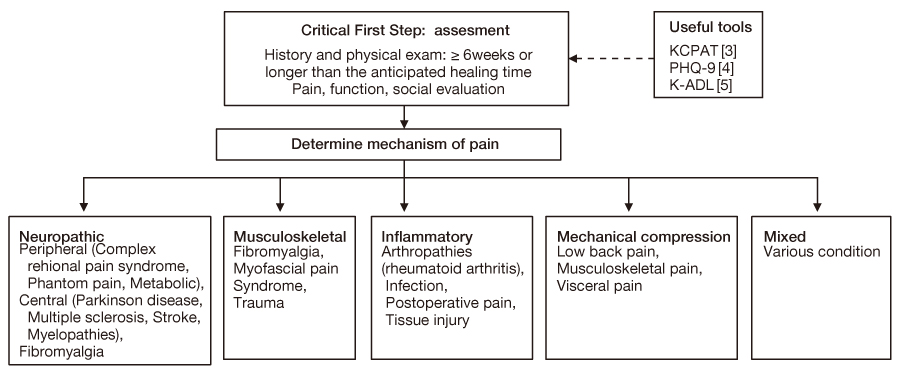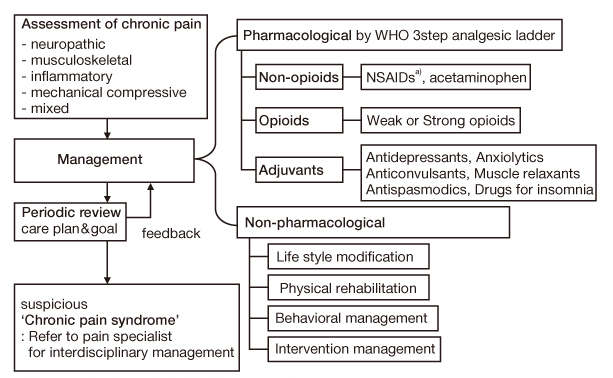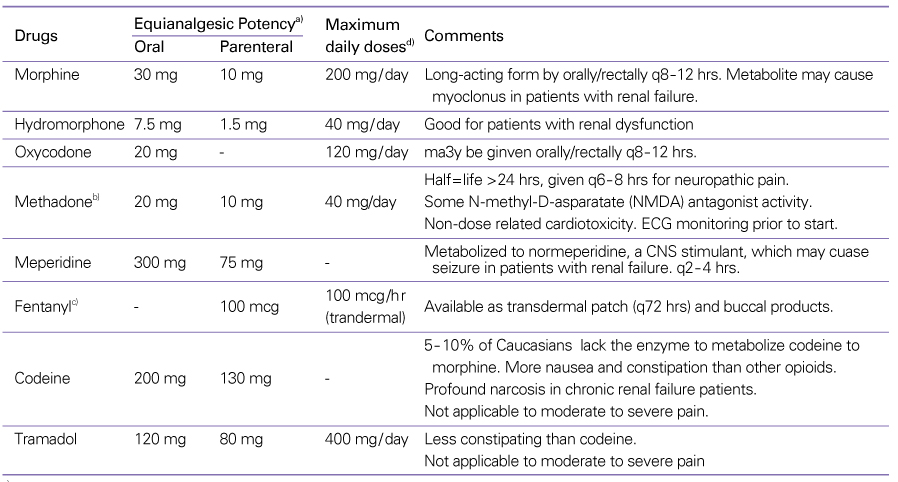 |
 |
- Search
| J Korean Med Assoc > Volume 53(9); 2010 > Article |
Abstract
Chronic pain is associated with disabling physical and emotional symptoms. Patients with chronic pain utilize more health services, have an impaired sense of well-being and frequently experience anxiety or depression. Unfortunately, treatment for chronic pain is not always correctly targeted, which leads to a reduced quality of life. Treatment of chronic pain involves a comprehensive approach using medication and functional rehabilitation. The usual approach for mild to moderate pain is to start with nonopioid analgesics. Also, trying antidepressant drugs for sleep loss and gabapentin for neuropathic pain or fibromyalgia is appropriate. For moderate to severe chronic pain, opioid analgesics can be used without any serious side effects if adequately used at the right dosage. It is important to provide guidance on the safe use of analgesics and other psychoactive drugs. Dosing of acetaminophen should be limited to avoid liver toxicity, and topical analgesics are preferred for focal pain. Full-dose nonsteroidal anti-inflammatory drugs should not be used for more than short periods, in order to avoid gastrointestinal, renal, and cardiovascular complications. Mechanisms of analgesia, drug selection, and recommendations for clinical usage for the management of chronic pain are reviewed in this paper.
References
1. Jackman RP, Purvis JM, Mallett BS. Chronic nonmalignant pain in primary care. Am Fam Physician 2008;78:1155-1162.
2. Health care guideline: Assessment and management of chronic pain. Institute for clinical systems improvement 2009;11. Accessed June 30, 2010. 4th ed. http://www.icsi.org/pain_chronic_assessment_and_management_of_14399/pain_chronic_assessment_and_management_of_guideline_.html
3. Choi YS, Park J, Lee MA, Yeom CH, Jang SK, Lee J. Reliability and Validity of the Evaluation of Korean Cancer Pain Assessment Tool (K-CPAT). Korean J hosp Palliat Care 2003;6:152-163.
4. Choi HS, Choi JH, Park KH, Joo KJ, Ga H, Ko HJ, Kim SR. Standardization of the Korean Version of Patient Health Questionnaire-9 as a Screening Instrument for Major Depressive Disorder. J Korean Acad Fam Med 2007;28:114-119.
5. Won CW. Functional Assessment of Daily Living (K-ADL, K-IADL). J Korean Acad Fam Med 2004;25:S. 617-618.
6. Kim JH, Choi YS. Chronic Pain Assessment and treatment in the elderly. Korean J Clin Geriatr 2008;9:225-232.
7. Park HJ, Moon DE. Pharmacologic management of chronic pain. Korean J Pain 2010;23:99-108.
8. Trescot AM, Helm S, Hansen H, Benyamin R, Glaser SE, Adlaka R, Patel S, Manchikanti L. Opioids in the management of chronic noncancer pain: an update of American Socisety of the Interventional Pain Physicians'(ASIPP) Guidelines. Pain Physician 2008;11:S5-S62.
9. Fine PG. Pharmacological management of persistent pain in older patients. Clin J Pain 2004;20:220-226.
11. Chou R, Fanciullo GJ, Fine PG, Adler JA, Ballantyne JC, Davies P, Donovan MI, Fishbain DA, Foley KM, Fudin J, Gilson AM, Kelter A, Mauskop A, O'Connor PG, Passik SD, Pasternak GW, Portenoy RK, Rich BA, Roberts RG, Todd KH, Miaskowski C. American Pain Society-American Academy of Pain Medicine Opioids Guidelines Panel. Clinical guidelines for the use of chronic opioid therapy in chronic noncancer pain. J Pain 2009;10:113-130.
12. Chen H, Lamer TJ, Rho RH, Marshall KA, Sitzman BT, Ghazi SM, Brewer RP. Contemporary management of neuropathic pain for the primary care physician. Mayo Clin Proc 2004;79:1533-1545.
13. Argoff CE, Backonja MM, Belgrade MJ, Bennett GJ, Clark MR, Cole BE, Fishbain DA, Irving GA, McCarberg BH, McLean MJ. Consensus guidelines: treatment planning and options. Mayo Clin Proc 2006;81:S12-S25.
- TOOLS
-
METRICS

-
Related articles in
J Korean Med Assoc -
Characteristics and management of juvenile type 2 diabetes mellitus2024 May;67(5)
Pharmacological treatment of Ménière disease2023 October;66(10)
Diagnosis and pharmacological management of allergic conjunctivitis2023 September;66(9)
Treatment with biological products for chronic urticaria2023 September;66(9)
Recent trends in the management of anterior knee pain2023 August;66(8)










